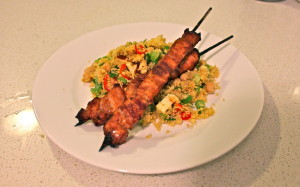
Kebabs, couscous, haloumi, and chilli. Four things I love! An easy recipe with a good amount of protein and flavour which doesn’t keep you in the kitchen for very long. Check it out below.
—
For the Couscous salad:
Method:
1. Bring stock to boil in a saucepan over high heat. Place couscous in a large bowl and pour the boiling stock over. Stir through with a fork. Leave covered for 5 minutes and stir through with a fork again to separate the grains.
2. Cut up haloumi into smaller pieces. Heat saucepan with oil over medium heat, and add haloumi. Cook for approximately 1-2 minutes each side or until golden brown.
3. Add haloumi to couscous along with spring onions, chilli, and chickpeas.
4. Make the dressing: whisk lemon rind, 1/4 cup lemon juice, paprika and oil in a bowl until properly combined.
5. Pour dressing over salad. Serve!
For the chicken kebabs:
Method:
1. Preheat a BBQ or pan on medium high, cook the kebabs while turning until properly cooked through.
2. Serve!

Diets, diets, diets…
It’s all the craze lately isn’t it? 30 Day cleanses, celebrity endorsements, sugar free this, paleo that. It’s hard not to be a little curious and question whether one diet is right for you. The question of which one is best for weight loss is certainly something that has been brought up in conversation with me in the last month or so. My answer has remained the same though: whichever diet or plan you can sustain for the long term is the diet that is right for you.
Those who follow the Facebook page must think I sound like a broken record, but the fact of the matter is, all health related goals should be made with a long term view. It should fit your lifestyle, and it definitely should take into account your personal preferences if you want to succeed, because what Pete Evans (Chef from My Kitchen Rules) may eat may not be what you want on your plate every day. Each person’s individual needs are different.
Be consistent with your plan, be flexible enough to enjoy a variety of foods, and be patient! I can’t stress that last point enough. Ups and downs are inevitable, so don’t beat yourself up and instead remain focus on the overall goal.
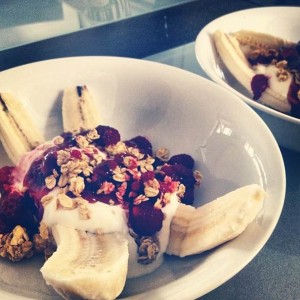
This breakfast/dessert idea is so simple a recipe is hardly needed. Here’s how it was done anyway.
Serves 1
1 ripe banana, peeled
1/2 cup Greek yogurt
2 tablespoons fruit jam or preserves
2 tablespoons sliced almonds or other nuts OR granola as is in the photo
1/4 cup fresh berries or other fresh fruit
Split the banana lengthwise and lay the two halves in a shallow bowl. Scoop out the yogurt and put it on top of the banana. Warm the jam in the microwave for 15 to 30 seconds or until it is very runny.
Use a spoon to drizzle the jam over the yogurt, and sprinkle the granola/nuts over everything. Top with raspberries/blueberries and dig in!
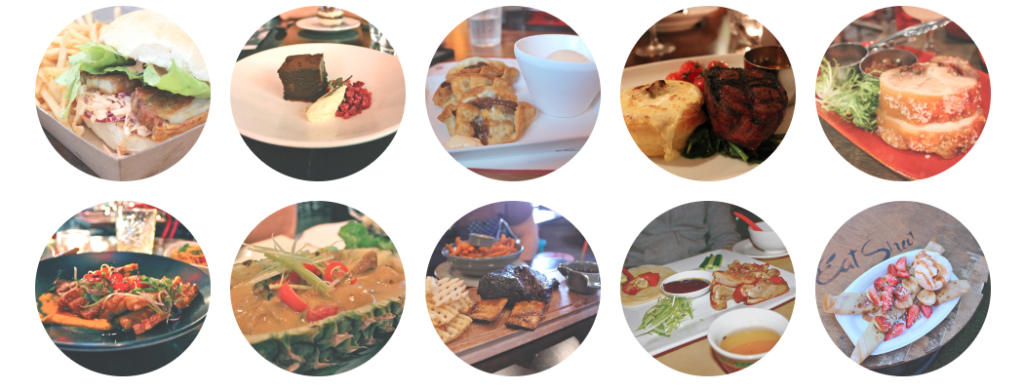
Strict ‘all or nothing’ approaches to food plans for clients are common amongst personal trainers and nutritionists. Often they result in failure due to their lack of flexibility. I’m all for being fit, healthy, and looking the part, but if a diet doesn’t have variety or allow me to indulge in foods I love, I’m not interested. Nonetheless, there is a diet option where you can literally, ‘have your cake and eat it too,’ and that’s by applying the moderation guideline. The moderation guideline is the 10-20% rule which is outlined in greater detail by leading nutritionist Alan Aragon.
In essence, the 10-20% rule allows you to eat whatever you want but still look great naked! Well, not quite, but with all things in life, everything should be in moderation. The basis of your diet should still come from whole and minimally refined foods. Reaching your minimum daily protein and fat intake (which varies for each individual) is still vital. If you are ticking these boxes, then consuming your go to indulgence foods is perfectly fine, as long as they are in moderation (10-20% of your daily Calorie target). Often dieting is too much of a psychological battle to stay within the parameters of a food plan because of lack of flexibility and variety, but with the 10-20% rule, this allows for indulgences more often than just the common ‘cheat meal.’ Of course, if someone chooses to have 0% of their food coming from sweets or processed food, that’s also perfectly fine.
As Alan Aragon has said, “Honouring personal preference is one of the most powerful yet underrated tactics for achieving optimal health and body composition.” Remember though, greater dietary flexibility is achieved by how high or low your physical activity levels are. So basically, consistent exercise is very important.
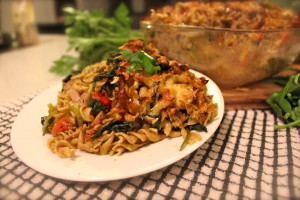
Who doesn’t love pasta?
Using wholemeal pasta for extra fibre (more than double fibre content of normal pasta), we combined basil flavoured tuna with a bunch of vegetables to make this. Pasta is more calorie dense than other foods and is often vilified, but eaten in a sensible serving is completely fine.
May have included a couple of Tim Tams for dessert… 😉
—
Ingredients:
- 500g wholemeal pasta
- 2 teaspoons olive oil
- 4 stalks of spring onions, finely chopped
- 2 garlic cloves, crushed
- 2 sticks celery, finely chopped
- 250g cherry tomatoes, halved
- 120g baby spinach
- 1/4 cup basil pesto
- 4 95g cans of Sirena Basil Infused Tuna
- grated light mozzarella cheese to coat
Method:
1. Preheat oven to 180°C. Cook pasta in a large saucepan of boiling, salted water, following packet directions, until tender. Drain.
2. Heat oil in a large frying pan over medium heat. Add onions, garlic and celery. Cook, stirring, for 2 minutes or until onion is soft. Add tomatoes. Cook for 2 minutes. Add spinach and pesto. Cook, stirring, for 2 minutes or until spinach just wilts. Add pasta to pan with tuna (undrained). Season with salt and pepper. Toss gently to combine.
3. Spoon mixture into a ceramic baking dish. Top with cheese. Bake for 20 minutes or until cheese is melted and golden. Stand for 5 minutes before serving.
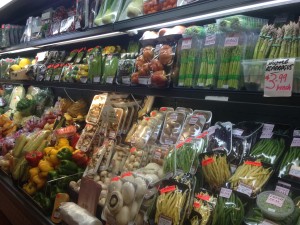
Superior Fruit Graceville
I’m sure many of you are familiar with, have seen or have heard of the glycemic index (GI). You know, those commercials and food labels that tell you why a particular food is more healthy because it is ‘low GI’. In short, the GI is a measure of how quickly a given food can raise blood sugar. The test is done solely on a specific carbohydrate food with a score between 1-100.
High GI foods such as sugar, white potatoes, cereal etc raise blood sugar more quickly, thus are scored higher. Low GI foods such as whole grains, nuts and vegetables do not cause the same rises in blood sugar, so are scored lower… But, do all the meals we consume only consist of high GI foods, or low GI foods? No. They are often a mix of both.
Consuming a high GI food (for example white potatoes) as part of a mixed meal of lower GI foods (vegetables, legumes) with a lean protein, would more than likely mean the overall GI of the meal is quite low. The vegetables and legumes in this case may slow the digestion of the white potatoes.
What does this mean for you?
Well, while you may see a lot of marketing to do with high GI and low GI foods, or have heard of people cutting out potatoes because of their GI score, just remember the GI index should not govern someone’s carbohydrate choices exclusively. Many different types of food both low and high GI have a wide range of vitamins and minerals which can benefit your health.
Eat a variety of whole and minimally processed foods and enjoy what is on your plate!
The best diets are the ones that consume all sorts of nutrients, as well as improve the performance, body composition (the amount of lean mass and fat mass present; basically how you look) and health of that individual.
To have a diet which contains all types of nutrients, you need to have VARIETY! Eating the same things each day, even if they are considered ‘good’ foods, means you are likely deficient in other areas of your nutrition.
Eat for your own health, your own performance, and your own body composition, but do yourself the favour and achieve all of that by eating a wide range of foods.
“Variety is the spice of life”






